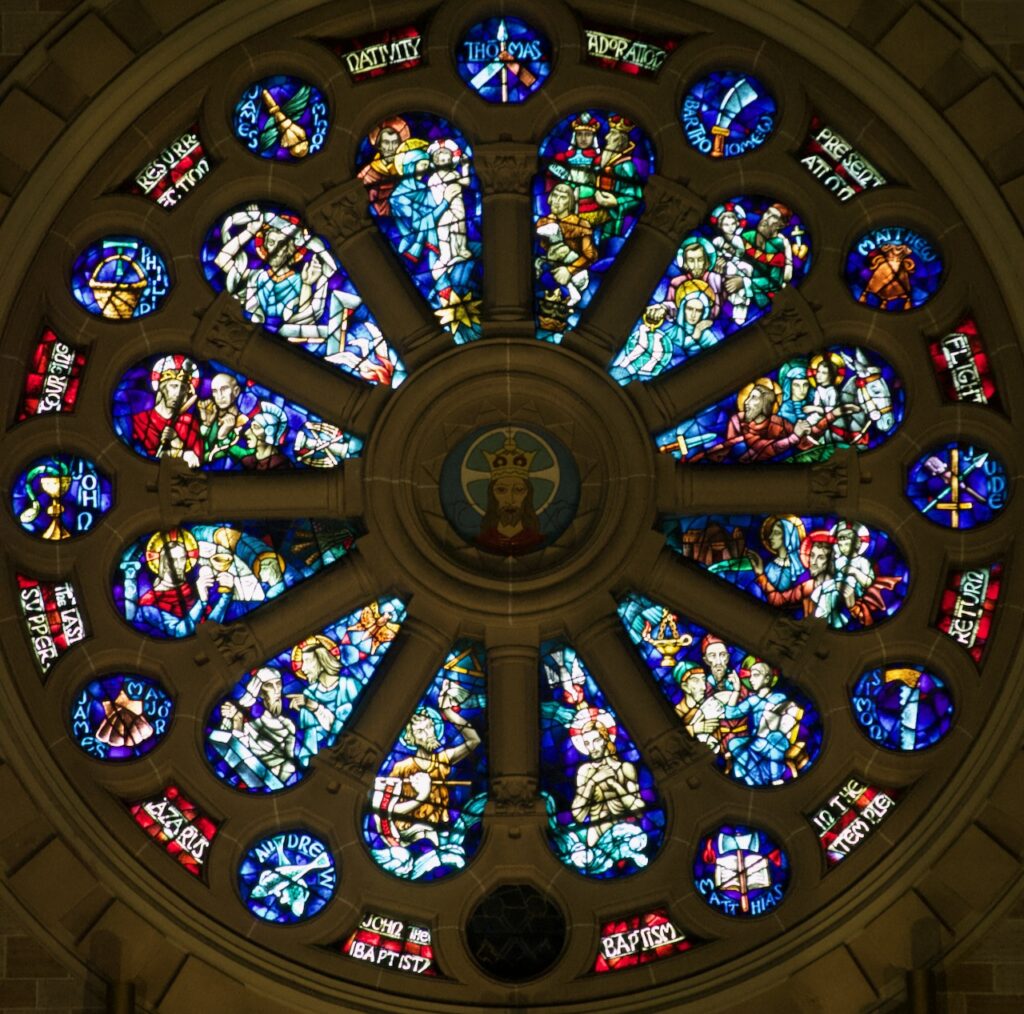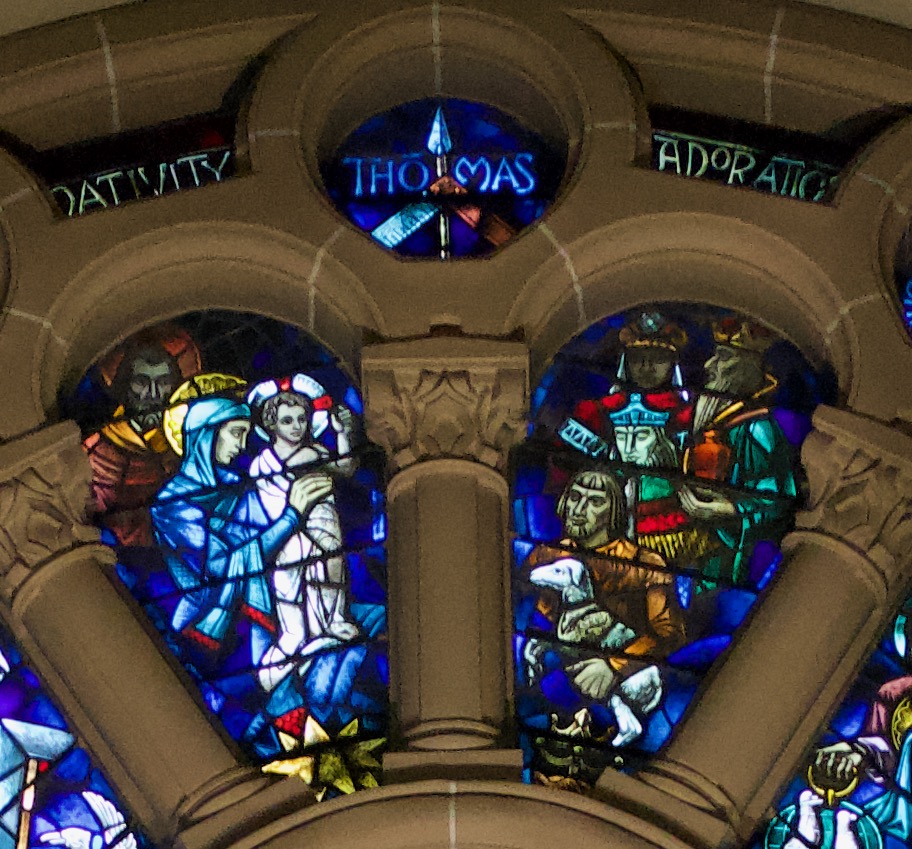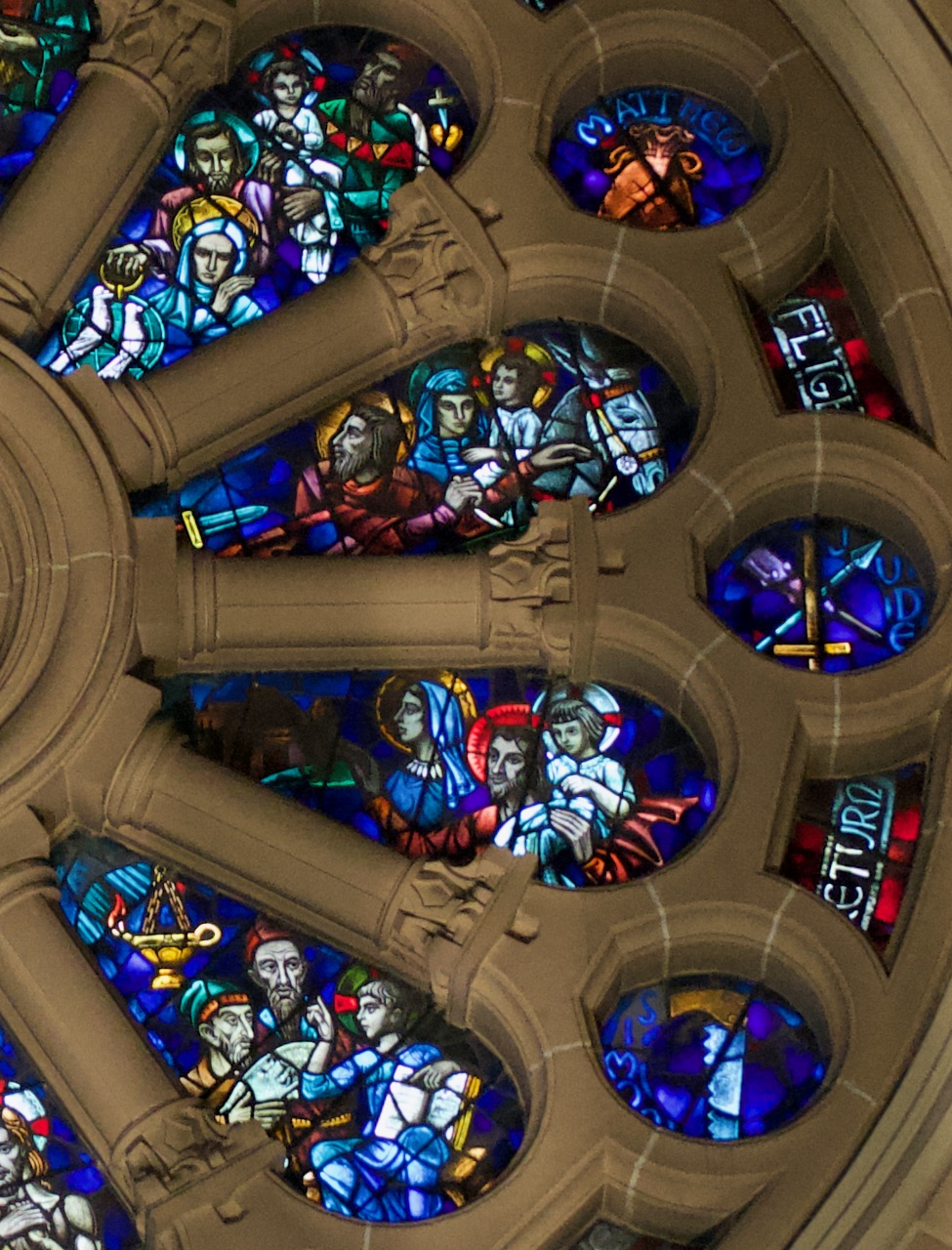
The rose window over the choir loft is dedicated to God the Son. It’s panes begin with the birth of Jesus and the events we celebrate during the Christmas season; proceed to His baptism marking the beginning of his public ministry (and the end of the Church’s Christmas time); and then depicts the events leading to his death and resurrection. Around the outside of the window are circular panes containing the names and symbols of the Apostles.

The top two panes illustrate the Christmas story as we hear it on Christmas Eve, Christmas Day, and Epiphany. In the first pane, Mary is holding Jesus, with Joseph standing behind. Mary is dressed in blue, her traditional color and also a symbol of heaven, spiritual love, and constancy. Jesus is dressed in white, a symbol of light, innocence, and glory. Joseph is dressed in brown, a symbol of humility.1 In the bottom corner of the pane is the star which the Magi followed to find the newborn King.
Hands are very important in the windows throughout the church. Jesus has his left hand raised, with three fingers pointing downward, a symbol of the Trinity, and his thumb and index fingers pointing upward, indicating His two natures: that He is fully human and fully divine.2
The second pane depicts the adoration of the shepherds and the Magi. The shepherd is holding his sheep and dressed in brown, the color of the earth, worn by humble and lowly people. The Magi behind him are dressed splendidly as kings. Two prominent colors in their garments, green and red, may symbolize the hope that this newborn king brings to the world, and the suffering and death that he will endure. The Magi hold their gifts. In the inner corner of this pane are three crowns. Since the three Magi are wearing crowns it is likely that these crowns represent the three offices of Jesus as Priest, Prophet, and King; offices that we share through our Baptism.
Between the top two panes is the circular pane representing Thomas. His symbols are a carpenter’s square and a lance.

The next pane depicts the Presentation of Jesus in the Temple, which we celebrate on February 2. Mary and Joseph have brought Jesus to the Temple to consecrate Him to the Lord and Joseph is holding the offering of the poor: two doves or pigeons. Simeon, dressed in green, is holding Jesus and recognizes him as the Messiah for whom he has hoped. He prophesies that Mary’s heart will be pierced as with a sword. A heart pierced by a sword is in the upper corner of the window and Mary’s hand is raised above her shoulder as if to ward off the blow and there is a troubled expression on her face. This is the first of the Seven Sorrows of Mary, which are depicted in the windows at the Mary altar.
We also see the pane representing Matthew, the tax collector who followed Jesus. His symbol is a bag of money, representing the profession that he gave up.
On December 28 we celebrate the Feast of the Holy Innocents. Herod had met the Magi and felt threatened by the presence of a newborn king. He ordered the death of all baby boys two years old and under. Joseph was warned in a dream to flee to Egypt. The next pane depicts that flight. Joseph is urging on the donkey that carries Mary and Jesus while looking back anxiously. The sword represents the danger which he is fleeing. After Herod died, Joseph was told in a dream to return to Israel with Jesus and Mary. The next pane depicts a more relaxed Joseph returning home with his family to settle in Nazareth.
In between these two panes is the pane representing Jude. His symbols are a club, a lance and an inverted cross. The next circle is for Simon and depicts a saw, symbol of how he was martyred.
On the Sunday after Christmas we celebrate the Feast of the Holy Family, and we hear the Gospel story of how Mary and Joseph lost Jesus as they were returning home from Jerusalem after Passover and how after three days they found him in the Temple. In the next pane Jesus is sitting among the teachers and conversing with them. He is holding a book, perhaps of the Scriptures. His left hand rests on the book with one finger seeming to point at it. The other three fingers are in the position often representing the Trinity in Christian art. His right hand seems to point to the sanctuary lamp, the symbol of His Father’s presence in the Temple. Jesus is the New Temple that will replace the old. He is the Divine fulfillment of the Old Testament Scriptures that he holds.
Although the Christmas Season is now passed and we are in Ordinary time, the Scripture passages which these panes illustrate can grow in us. We can be aware of the mystery that Jesus is both human and divine, like us in all things but sin. We can bring our gifts to him in every Mass as the Magi brought their gifts when he was an infant. We can ask God to help us grow in hope, as Simeon did. We can ask Mary and St. Joseph to help us when the world around us is frightening. And we can grow in our belief that Jesus is indeed our Savior, born to free us from the bondage of our sins.
References
- Sill, Gertrude Grace. (1975) A Handbook of Symbols in Christian Art. Macmillan Publishing Company. pp. 29-30.
- Capato, Kate. (2023) Symbolism of Jesus Hand Position. visualgrace.org. https://visualgrace.org/symbolism-of-jesus-in-sacred-artwork-not-done-tie-in-christmas